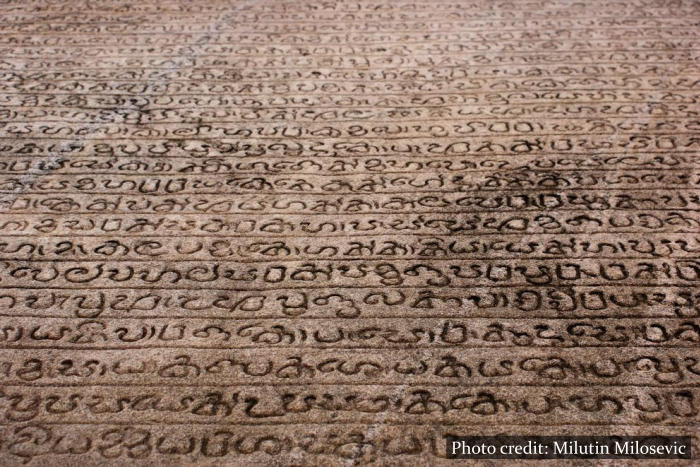
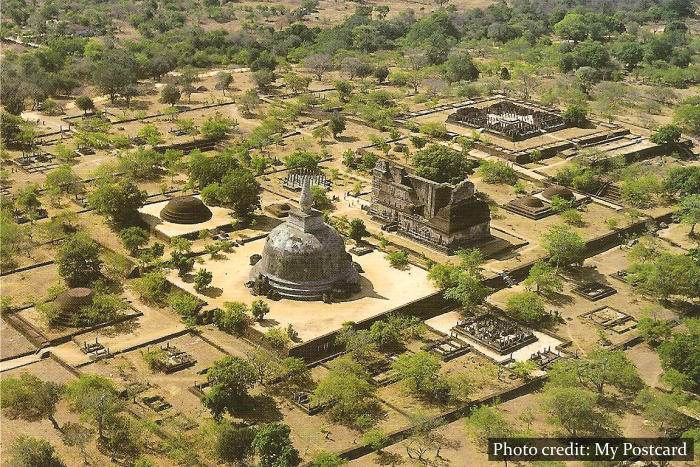
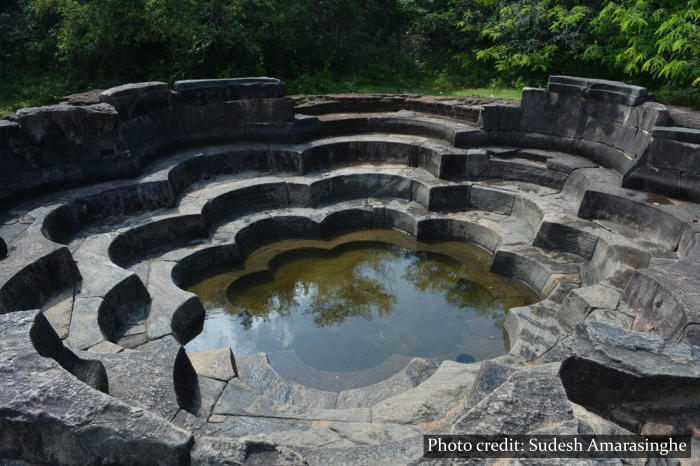
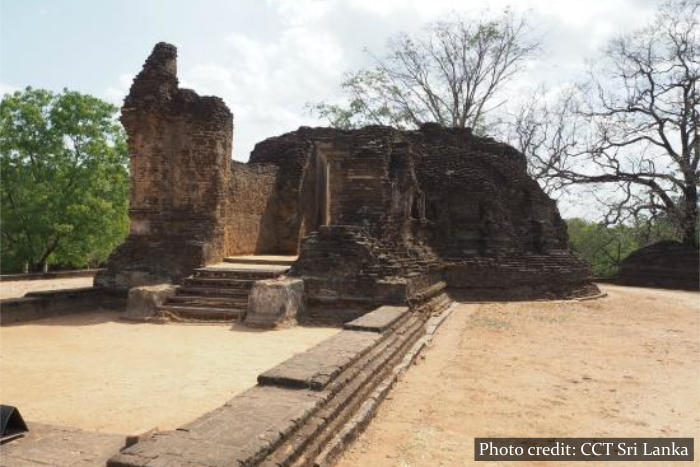
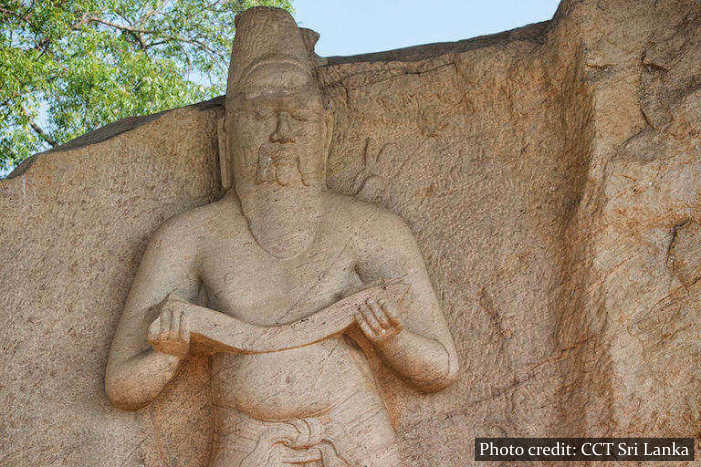
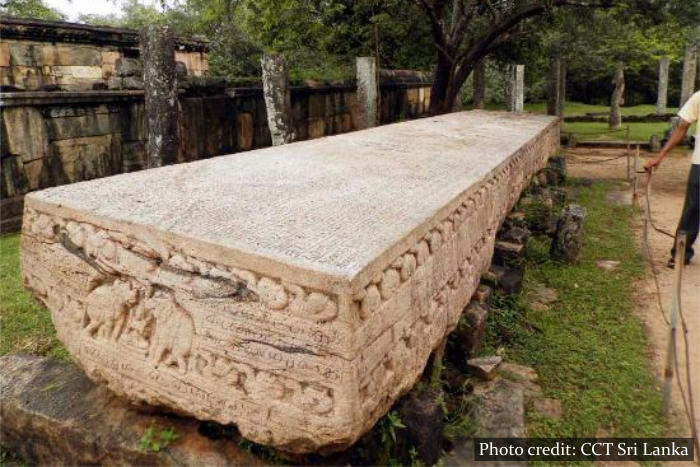
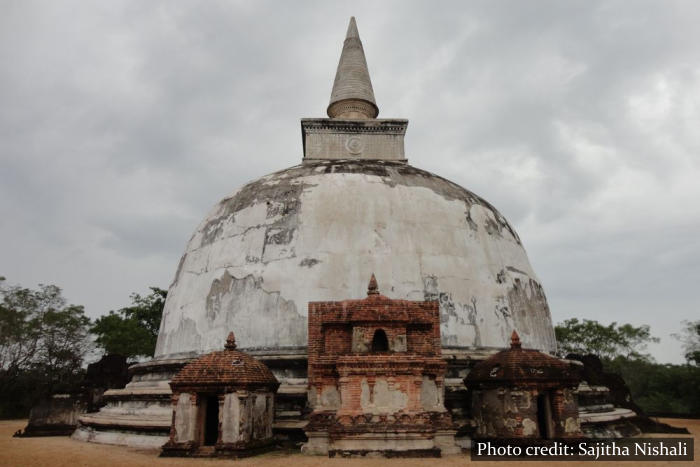
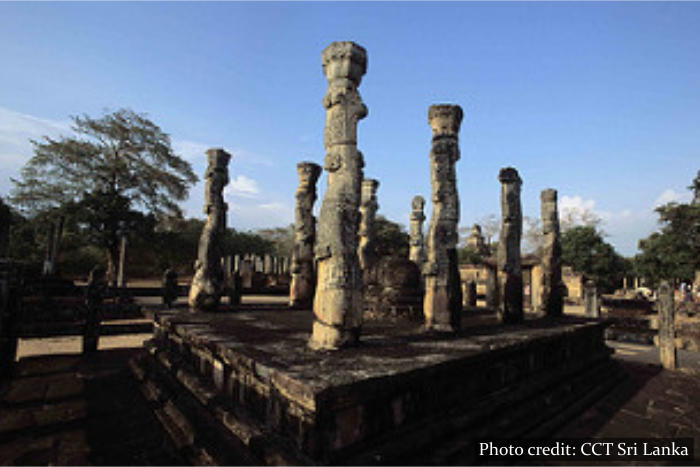
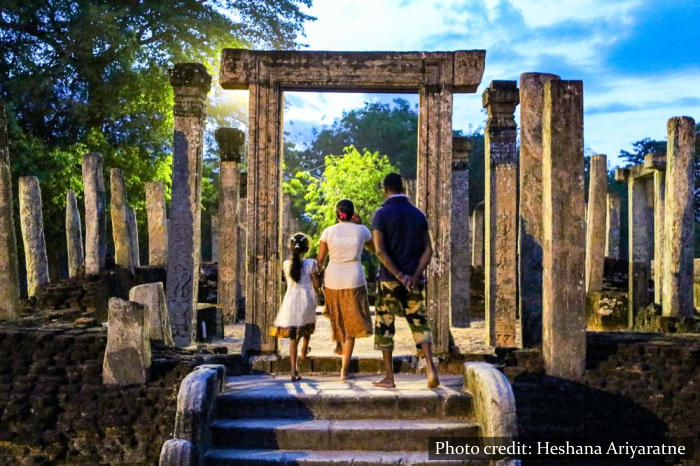
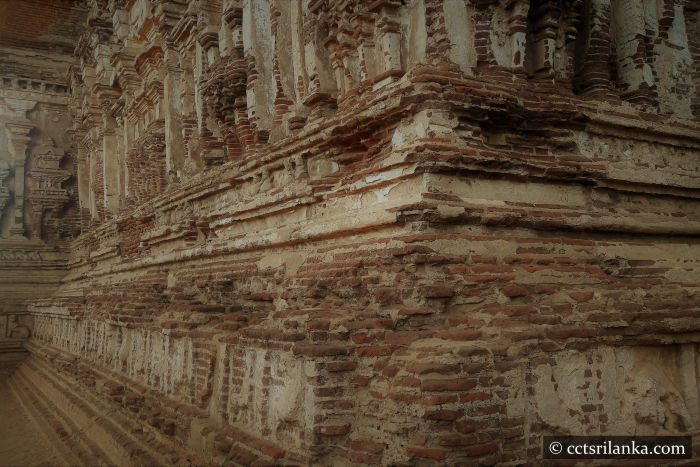
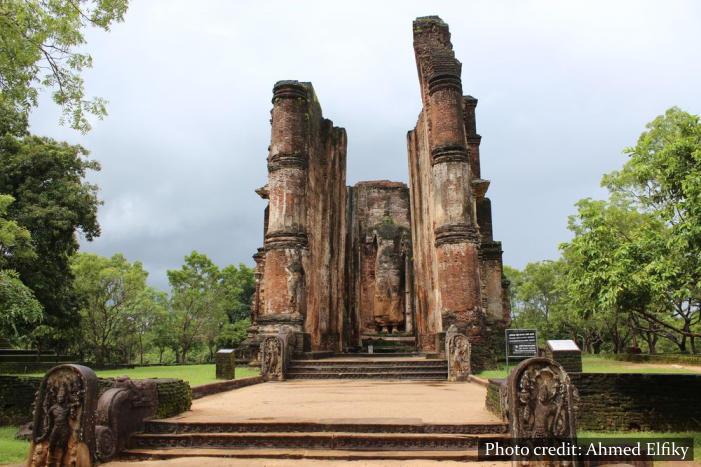
Polonnaruwa City Tour – Half Day Exploration
Discover the wonders of Polonnaruwa, a UNESCO World Heritage site, on a half-day tour led by one of CCT Sri Lanka’s professional historians. Immerse yourself in the rich history and timeless beauty of this ancient city as you visit key landmarks, including:
- Vijayabahu Palace | Shiva Temples | Pabalu Stupa | Vataga | Stone Book Inscription | Alahana Pirivena | Lankathilaka Image House | Gal Viharaya | Thivanka Image House | Polonnaruwa Museum | Parakramabahu Image and Site | Medirigiriya, Dimbulagala, or Angamedilla Anicut
What You Will Learn
Gain deep insights into the remarkable history of the region, including:
- The strategies behind ancient settlement shifts | Ancient architectural techniques and building materials
- The influence of Hinduism on Sri Lanka’s heritage | The evolution of ancient hospitals and healthcare systems
- The role of marginal monasteries in spiritual life | The pioneering irrigation technologies that transformed the land
Meet Your Guide
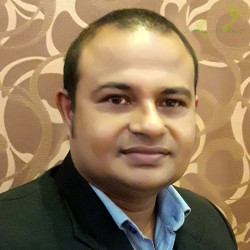 Our team of professionals brings a blend of extensive field research experience and strong academic expertise to make your journey both enriching and insightful. Among our distinguished experts is Dr. Thusitha (Dr. rer. nat), whose knowledge and passion elevate every exploration:
Our team of professionals brings a blend of extensive field research experience and strong academic expertise to make your journey both enriching and insightful. Among our distinguished experts is Dr. Thusitha (Dr. rer. nat), whose knowledge and passion elevate every exploration:
- Education: PhD from Freie Universität Berlin
- Work Experience: Former Research Assistant at the Department of Archaeology, university lecturer, and accomplished writer.
- Field Experience: Managed over 25 excavation sites since 2001, demonstrating profound expertise in archaeological site management and historical research.
f you’re interested, Dr. Thusitha is happy to share his insights, answer your questions, and engage in meaningful discussions over a relaxing cup of tea or coffee after the excursion—ensuring your experience of Polonnaruwa is truly unforgettable.
For independent travelers, we encourage exploring this page beforehand to learn about each site and fully immerse yourself in the rich history of Polonnaruwa.
Join us for an unforgettable exploration where history comes alive, offering countless opportunities to learn and connect with Sri Lanka's remarkable past.
Why Choose CCT Sri Lanka?
Registered and Professional Experts: CCT Sri Lanka (Cross Country Travels) is a locally owned, fully registered company with the Sri Lanka Tourism Development Authority and Civil Aviation Authority.
Certified Drivers & Guides: Our licensed, passionate guides are dedicated to providing enriching and awe-inspiring experiences throughout your journey.
Sustainability: Every penny you spend with us directly benefits Sri Lanka—helping ease its debt-stricken economy, empower local communities, and preserve the island's stunning nature.
Book Your Adventure Now: Secure your spot through our safe, easy booking system on this page and get ready to embark on an unforgettable journey.
Polonnaruwa City Tour
Best season : All year around
Available : Daily
Best time to start : Early mornings
Arranging time needed : 1 day
Pick up point : Within 5 KMs from Polonnaruwa city center.
Starting time : 8 AM or 2 PM
Lunch break : 1 hrs
Finishing time : 12 Noon or 6 PM
Transportation : Select from above - Our guide uses your transportation
General & specific restrictions : No flash photography of ancient paintings / Cover your knees and shoulders before enter any temple / Do not leave plastics behind / Please do not feed wild animals.
Price includes : Transportation / Entrance tickets to Polonnaruwa UNESCO site / Professional guide / Evening round the table discussion if you are interested / All Gov tax.
Child price : Aged 6 - 12 is considered a child / Aged 0 - 6 is free of charge.
Feedback us : Our drivers and service providers are advised not to promote any other activities or nudge you for shopping. Please leave your feedback on Google.
You may bring : Water / Sandals or shoes which easily removable / Pair of socks if you do not like to walk barefoot / Clothes which cover your shoulders and knees / Hat and sun glass / Sun creams / Camera
Reserve your bicycle : Click here
We love holiday planning!
Recent reviews
-
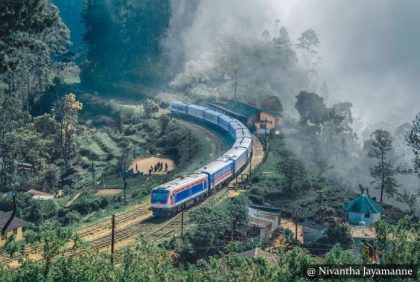 Book Train Tickets Online in Sri Lanka
Rated 5 out of 5by Vedanth Sameer Rao
Book Train Tickets Online in Sri Lanka
Rated 5 out of 5by Vedanth Sameer Rao -
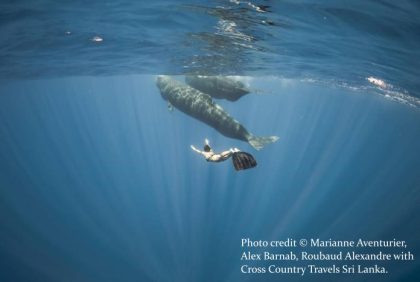 Whale Watching in Sri Lanka - Shared Luxury Yacht
Rated 5 out of 5by Julie
Whale Watching in Sri Lanka - Shared Luxury Yacht
Rated 5 out of 5by Julie -
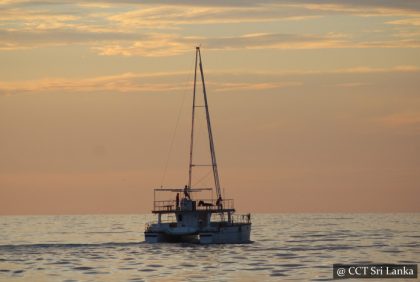 Colombo Port City Charter Sailing - 3 or 5 hrs - For Foreign Guests
Rated 5 out of 5by Sathsarani
Colombo Port City Charter Sailing - 3 or 5 hrs - For Foreign Guests
Rated 5 out of 5by Sathsarani -
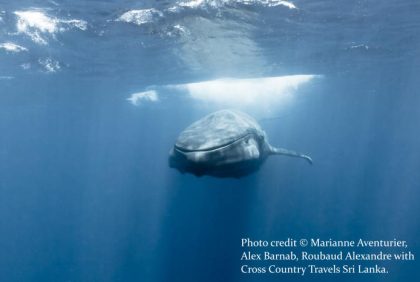 Snorkeling With Whales
Rated 5 out of 5by Arne
Snorkeling With Whales
Rated 5 out of 5by Arne -
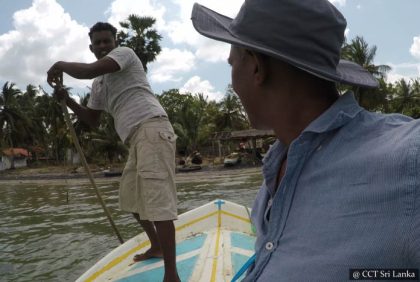 Speedy 10-Minute Boat Ride - Wilpattu to Kalpitiya
Rated 5 out of 5by Ada
Speedy 10-Minute Boat Ride - Wilpattu to Kalpitiya
Rated 5 out of 5by Ada -
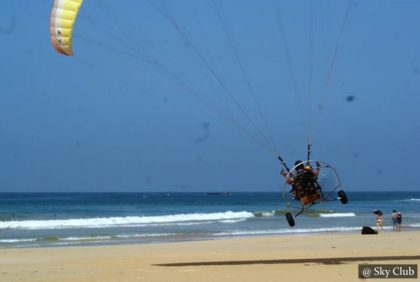 Paramotoring in Sri Lanka - Bentota
Rated 5 out of 5by Kash
Paramotoring in Sri Lanka - Bentota
Rated 5 out of 5by Kash -
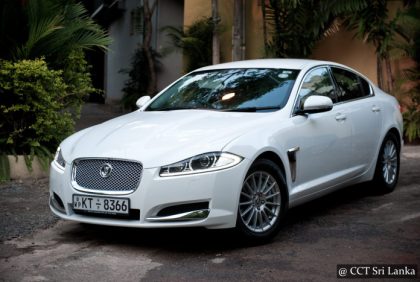 Reserve Your Vehicle With a Driver
Rated 5 out of 5by Steve
Reserve Your Vehicle With a Driver
Rated 5 out of 5by Steve -
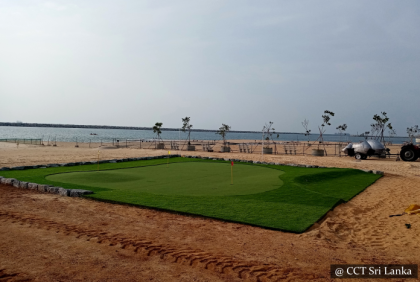 Colombo Port City - Golf Drive Range
Rated 5 out of 5by Chandula Wanasinghe
Colombo Port City - Golf Drive Range
Rated 5 out of 5by Chandula Wanasinghe -
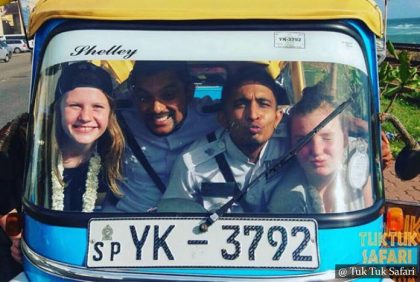 Reserve a Tuk Tuks - Unlimited Kms
Rated 5 out of 5by Thomas Ask
Reserve a Tuk Tuks - Unlimited Kms
Rated 5 out of 5by Thomas Ask -
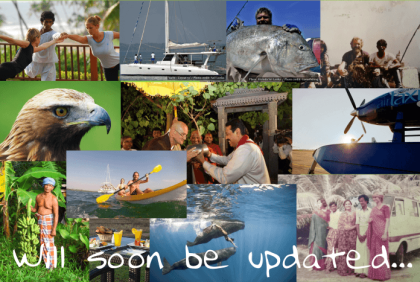 Nil Diya Pokuna Caving - For Foreign Visitors
Rated 5 out of 5by Anuj gunasena
Nil Diya Pokuna Caving - For Foreign Visitors
Rated 5 out of 5by Anuj gunasena -
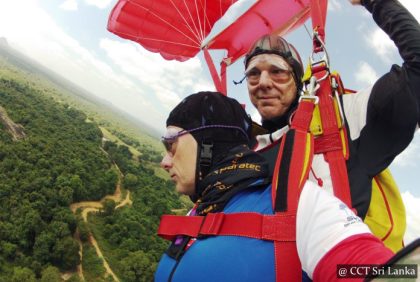 Skydiving - Sri Lanka
Rated 5 out of 5by Veno
Skydiving - Sri Lanka
Rated 5 out of 5by Veno
Ultimate Guide to the Polonnaruwa UNESCO Site
Polonnaruwa (පොළොන්නරුව) Ancient City Complex (1,070 - 1,214 AD)
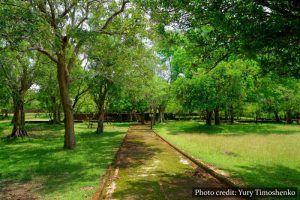
In 993 AD, the Anuradhapura Kingdom fell to the invasion of Raja Raja Chola I, marking the beginning of a new era. The northern region of Sri Lanka, known as Rajarata—bounded by the Daduru Oya and Mahaweli Ganga rivers—came under the rule of the Chola dynasty. For nearly 80 years, four Chola kings ruled the region, with Polonnaruwa serving as their capital, renamed Jananathamangalam by the Cholas. Raja Raja Chola I himself built a Siva temple in Polonnaruwa to celebrate his victory.
In 1,070 AD, King Vijayabahu I of Ruhuna, after 17 years of military campaigns, succeeded in reclaiming the capital city of Rajarata. He renamed it Vijayarajapura, unifying the island once more under a single sovereign ruler. King Vijayabahu also revitalized Theravada Buddhism and undertook the restoration of damaged infrastructure, temples, and water reservoirs, alongside the construction of new ones.
King Parakramabahu I later emerged as a powerful leader, not only defending the island but also engaging in wars with foreign nations, bringing immense pride to Sri Lanka. However, after his reign, the island became vulnerable to foreign invasions and internal conflicts. In 1,215, the invasion of Rajarata by Kalinga Magha marked the beginning of the decline of the Polonnaruwa Kingdom.
An intriguing aspect of Polonnaruwa is its alternate name, Pulasthipura. One of the city's iconic landmarks, a towering 11.5-foot statue near the Parakramabahu Reservoir, is believed by some to be that of Pulastya, an ancient sage. According to legend, King Ravana of Sri Lanka, known for his might, was the grandson of Pulastya, with his father being Visravas. If we accept this mythological connection, then Polonnaruwa could be seen as a site with a rich history spanning 7,000 to 10,000 years. However, there are many who strongly disagree with this interpretation.
King Vijayabahu I (1039–1110 AD):
Reign: 1055–1110 AD
Born as Prince Kitti (Keerthi), he was the son of King Moggallana, a ruler of Ruhuna. His early life was spent in the village of Mulasala.
At just 15 or 16 years old, young Kitti made his mark on history with his first political assassination, followed by another a year later of Kesadhatu, the ruler of Ruhuna. These acts earned him the name Vijayabahu, and his skill as an archer further cemented his reputation.
The Rise to Sovereignty
As ruler of Ruhuna, Vijayabahu spent 15–16 years fortifying his position and preparing to challenge the Chola rulers in Polonnaruwa. His first attempt to reclaim Polonnaruwa failed, but his perseverance paid off during his second campaign. Taking advantage of civil unrest in Tamil Nadu, he launched a well-coordinated three-pronged assault:
- One battalion was dispatched to Mahathittha to block supplies from South India.
- Two other battalions attacked Polonnaruwa from the South and East.
This strategy succeeded, and Vijayabahu secured Polonnaruwa, becoming the sovereign ruler of a unified Sri Lanka.
Royal Alliances
King Vijayabahu married Princess Lilavati, the daughter of Prince Jayatipala of Kanauj, as his chief queen. His second queen, Princess Thiloka Sundari, hailed from the Kalinga Royal Family (modern-day Bangladesh). They had two children:
- Vikramabahu, who succeeded him after assassinating his uncle, Prince Jayabahu.
- Ratnavali, who later married Manabharana, a Pandya prince, and became the mother of the great King Parakramabahu I.
The King also established significant diplomatic ties, marrying his sister Mitta to a Pandya prince in Tamil Nadu, resulting in three sons, one of whom married Ratnavali.
Contributions to Religion and Culture
Vijayabahu I was a devout Buddhist and worked to revive the religion in Sri Lanka:
- He sent five monks to Burma for higher ordination, strengthening ties with Burma and re-establishing Theravada Buddhism in the kingdom.
- He repaired abandoned Buddhist temples and built a new shrine in Polonnaruwa for the Sacred Tooth Relic.
- Resting places for pilgrims on their journey to Samanala Kanda (Adam’s Peak) were constructed, as confirmed by the Ambagamu Sannasa inscriptions found in Nuwara Eliya.
Despite his Buddhist devotion, he preserved the Hindu temples built by the Cholas and included Tamil mercenaries in his army, reflecting his inclusive approach to governance.
Contributions to Infrastructure
The King undertook significant irrigation projects:
- Repaired existing tanks and reservoirs.
- Constructed new irrigation systems, ensuring agricultural prosperity.
Historical Records
Two key inscriptions provide detailed accounts of his reign:
- Velaikkara Slab Inscription in Polonnaruwa, which chronicles his accomplishments.
- Paana Kaduwa Thamba Sannasa (Copper Plate Inscription), discovered in 1949, which reveals his gratitude towards his mentor, Dandanayake Budalnawanata, who cared for his family during his childhood.
King Vijayabahu I’s reign marked the resurgence of Sri Lankan sovereignty, religious revival, and infrastructural development, leaving an enduring legacy in the nation’s history.
King Parakramabahu I (1123–1186 AD)
Reign: 1153–1186 AD
After the death of King Vijayabahu I, Sri Lanka fragmented into three principalities: Rajarata, Dakkhinadesa, and Ruhuna. It was amidst this divided political landscape that Prince Parakramabahu was born in Peeligama (or Punkagama) in Dakkhinadesa, to its ruler, Manabharana, and his wife, Ratnavali. Tragically, his father passed away soon after his birth. His uncle, Kittisirimegha, assumed control of Dakkhinadesa, while his other uncle, Sirivallabha, ruler of Ruhuna, adopted Parakramabahu, his two sisters, and their mother.
Early Life and Rise
As a young prince, Parakramabahu showed remarkable ambition and talent. He initially lived in Ruhuna under the care of Sirivallabha but soon returned to Dakkhinadesa, where he was educated in Sankhatthali. Despite his early education and opportunities, he found the tribal kingship system too limiting for his aspirations.
Determined to broaden his horizons, he sought refuge with King Gajabahu of Rajarata. On his way, Parakramabahu had to slay his teacher, Senpathi Sanka, who had informed Kittisirimegha of his plans to defect. Despite this turbulent beginning, he earned a position in King Gajabahu's court and married the king’s sister.
However, Parakramabahu eventually returned to Dakkhinadesa, where he ascended to the throne after Kittisirimegha’s death.
Path to Monarchy
Parakramabahu’s military prowess soon came to the fore. He captured Polonnaruwa and imprisoned King Gajabahu, though the king was later freed by Parakramabahu’s nephew, Manabharana of Ruhuna. After King Gajabahu’s natural death, Parakramabahu consolidated his power, defeating his rivals, and was crowned as the sole ruler of Sri Lanka in Polonnaruwa.
Military Campaigns Abroad
In 1165, Parakramabahu waged war against King Narathu of Burma. This was partly due to the capture of envoys headed to Cambodia and disputes over elephant trade. Parakramabahu’s forces triumphed after five months, assassinating Narathu and restoring peace in Burma.
In 1167, the Pandyan king Parakrama of Tamil Nadu sought his aid against King Kulasekhara and a Chola ruler. Although Parakrama was killed before his arrival, Parakramabahu’s army defeated Kulasekhara and secured the throne for Parakrama’s son, Virapandu. However, conflicting Chola records claim that the Lankan general Lankapura and his officers were defeated, with their heads displayed at Madurai’s gates.
Religious and Cultural Reforms
King Parakramabahu was a unifier of the Mahaviharaya, Abayagiri Viharaya, and Jetavana Viharaya sects of Buddhism. Under the guidance of Maha Thero Kassapa, he held a convocation to address disputes and corruption among the clergy.
He rebuilt and restored numerous temples and cities devastated by the Cholas, including Anuradhapura. His notable architectural contributions in Polonnaruwa include the breathtaking Gal Viharaya, Lankathilaka Viharaya, Alahana Pirivena, and the Hatadage. He even used Tamil prisoners of war to construct the Demala Maha Cetiya.
Agricultural and Irrigation Achievements
Parakramabahu’s reign is celebrated for his vast irrigation projects, which transformed the landscape of Sri Lanka. He constructed and repaired reservoirs and canals, with the Parakrama Samudraya being his most famous achievement. The fertile wetlands near modern highways to Colombo were once thriving paddy fields under his irrigation system.
Legacy
King Parakramabahu I is remembered as one of Sri Lanka’s greatest monarchs—a warrior, builder, and reformer who unified the island, restored its prosperity, and left a lasting cultural and agricultural legacy. To delve deeper into his life and achievements, refer to Chapters 62–79 of the Culavamsa (Choolavansha).
Kalinga Magha (Reigned 1215–1236)
After the death of King Parakramabahu I, the lack of a strong successor led to political instability. The throne of Polonnaruwa saw a series of rulers, many of whom reigned briefly. The exceptions included Nissanka Malla (1187–1196), a ruler with no connection to previous dynasties, who contributed notable monuments like the Nissanka Latha Mandapaya. However, this period was characterized by a rapid turnover of rulers—twelve in total—before Kalinga Magha's arrival.
The Rise of Kalinga Magha
In 1215, Kalinga Magha, a prince of Kalinga (modern-day Odisha, India), landed in Karainagar. At this time, Polonnaruwa was under the rule of Parakrama Pandyan II. Ironically, his predecessor, Parakrama Pandyan I, had once been supported by King Parakramabahu I in Madurai in 1167.
Kalinga Magha swiftly captured Polonnaruwa, ushering in a reign marked by ruthlessness and devastation. He imposed Hinduism as the state religion and systematically destroyed Buddhist temples, monasteries, and other cultural sites. Unlike his predecessors, Kalinga Magha neglected infrastructure, leaving no notable development projects to his name.
The Fall of Kalinga Magha
In 1236, Kalinga Magha was expelled from Polonnaruwa by Chandrabhanu, a king from Thailand, who led an invasion of Sri Lanka. Kalinga Magha retreated to Jaffna, where he established his authority over the Jaffna Kingdom and ruled until 1255.
The Shift of Power
Kalinga Magha’s reign marked the decline of Polonnaruwa as the center of Sri Lanka’s Buddhist civilization. The political and cultural heart of the island shifted to Dambadeniya, as Sinhalese kings sought refuge from foreign invasions and sought to rebuild their kingdom.
Kalinga Magha remains one of the most notorious figures in Sri Lankan history, remembered for his harsh rule and the cultural and religious upheaval he caused.
Royal Palace (Vejayanta Pasada)
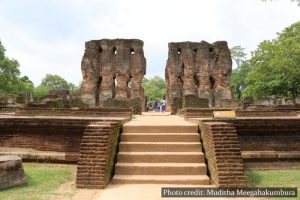 The Royal Palace, a remarkable architectural feat, was constructed during the reign of King Parakramabahu I. It is believed to have stood five stories high, showcasing the grandeur and ingenuity of the period. The palace, named Vejayanta Pasada after the heavenly abode of God Sakra, is a testament to the king's ambition and reverence for divine inspiration.
The Royal Palace, a remarkable architectural feat, was constructed during the reign of King Parakramabahu I. It is believed to have stood five stories high, showcasing the grandeur and ingenuity of the period. The palace, named Vejayanta Pasada after the heavenly abode of God Sakra, is a testament to the king's ambition and reverence for divine inspiration.
Upon entering the palace, visitors are greeted by a grand hall supported by massive, thick walls. This hall likely served as the audience chamber, where royal meetings and state affairs were conducted. The complex also included separate quarters for the queens, accommodations for officials, lush parks, and elaborate bathing areas, reflecting the opulence of the royal lifestyle.
The palace complex was fortified with a wide rampart, complete with watchtowers, turrets, ponds, and walking paths, providing both security and aesthetic charm. Today, the ruins of this majestic brick structure stand as a testament to the architectural brilliance and cultural legacy of the Polonnaruwa Kingdom.
Vatadage
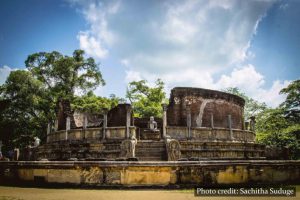
The Vatadage, constructed during the reign of King Parakramabahu I, is one of Polonnaruwa’s most iconic monuments. The name "Vatadage" translates to "encircled structure," referencing its circular design and architectural elegance.
At its uppermost level lies a central shrine, which once housed the Tooth Relic of Lord Buddha, a symbol of great reverence. Surrounding this shrine are four seated Buddha statues, oriented to the cardinal directions, creating a harmonious and spiritual ambiance.
The entrance to the Vatadage features exquisite craftsmanship, particularly at the foot of the second stairwell, where lies the most beautifully preserved moonstone of the Polonnaruwa era. This intricately carved semi-circular stone is considered a masterpiece of ancient Sri Lankan art, depicting layers of symbolic imagery.
The Vatadage stands as a testament to Polonnaruwa’s rich architectural and spiritual heritage, captivating all who visit.
Atadage
The Atadage, constructed during the reign of King Vijayabahu I, is a remarkable monument and the first Tooth Relic Temple in Polonnaruwa. The name "Atadage" translates to "The House of Eight Relics," signifying its importance as a sacred site.
Today, the structure stands as a ruin, with 54 stone pillars remaining, which once supported an upper floor where the sacred relics were housed. Intricate inscriptions, including some in Tamil, are carved on these pillars. Notably, a Tamil inscription calls upon Tamil guards from South India to safeguard the relic, highlighting the multicultural influences of the era.
A nearly 3-meter-tall Buddha statue still graces the site, standing as a testament to the temple's spiritual and historical significance. This revered monument continues to draw admiration for its architectural brilliance and profound cultural heritage.
Vatadage

The Vatadage, constructed during the reign of King Parakramabahu I, is one of Polonnaruwa’s most iconic monuments. The name "Vatadage" translates to "encircled structure," referencing its circular design and architectural elegance.
At its uppermost level lies a central shrine, which once housed the Tooth Relic of Lord Buddha, a symbol of great reverence. Surrounding this shrine are four seated Buddha statues, oriented to the cardinal directions, creating a harmonious and spiritual ambiance.
The entrance to the Vatadage features exquisite craftsmanship, particularly at the foot of the second stairwell, where lies the most beautifully preserved moonstone of the Polonnaruwa era. This intricately carved semi-circular stone is considered a masterpiece of ancient Sri Lankan art, depicting layers of symbolic imagery.
The Vatadage stands as a testament to Polonnaruwa’s rich architectural and spiritual heritage, captivating all who visit.
Hatadage
The Hatadage, constructed during the reign of King Nissankamalla, was a significant structure in Polonnaruwa as it housed the Sacred Tooth Relic of Lord Buddha.
This ancient relic chamber reflects both spiritual reverence and architectural ingenuity. Inscriptions attributed to King Nissankamalla can be observed on the outer wall and within the first chamber, providing valuable historical context.
A staircase leading to an upper floor is still visible, though no remnants of the upper level remain today. The Hatadage, with its intricate carvings and inscriptions, continues to be a remarkable site for those seeking to explore Sri Lanka's rich Buddhist heritage.
Nissanka Latha Mandapaya
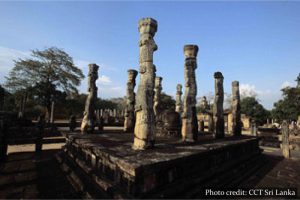
The Nissanka Latha Mandapaya, built during the reign of King Nissankamalla, is celebrated for its remarkable granite craftsmanship and unique architectural style.
Unlike conventional straight pillars, the Mandapaya features beautifully curved, flower-like columns, giving the structure an ethereal elegance. The name "Latha Mandapaya" translates to "Elegant Stage," perfectly capturing its delicate beauty.
Historical accounts suggest that the Mandapaya once supported a timber roof, which sheltered a small stupa at its center. Today, the intricate design and artistry of this structure continue to captivate visitors, offering a glimpse into the creativity and sophistication of Polonnaruwa's golden era.
Gal Potha
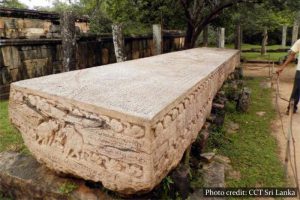 The Gal Potha, or "Stone Book," is an impressive inscription from the reign of King Nissankamalla. This massive stone slab measures approximately 8 meters in length and 1.2 meters in width, resembling an ancient manuscript.
The Gal Potha, or "Stone Book," is an impressive inscription from the reign of King Nissankamalla. This massive stone slab measures approximately 8 meters in length and 1.2 meters in width, resembling an ancient manuscript.
The inscriptions on the stone detail the achievements and exploits of King Nissankamalla, including his supposed ties to other nations. However, historical evidence suggests that such claims were largely exaggerated, as Nissankamalla's reign lasted only nine years, during a period when political instability allowed for frequent changes in leadership.
One notable feature of the Gal Potha is the intricate carving on its side, depicting two elephants showering the Goddess Lakshmi, symbolizing prosperity and abundance. This artistic detail adds a touch of grandeur to the artifact, making it a fascinating relic of the Polonnaruwa era.
Sathmahal Prasada

The Sathmahal Prasada is a unique and intriguing structure in Polonnaruwa, notable for its distinctive architecture. It is one of only three such buildings in Sri Lanka, with the other two located in Anuradhapura. The design of the Sathmahal Prasada is believed to be inspired by ancient Cambodian or Siamese architecture, reflecting cultural influences from Southeast Asia.
This remarkable building stands as a testament to the chaotic period following the reign of King Parakramabahu I. During this time, Polonnaruwa faced a series of foreign invasions, including the Kalinga Magha occupation, as mentioned earlier. The influence of rulers from South India and even Thailand is evident in the architectural style of the Sathmahal Prasada, symbolizing the diverse cultural and political upheavals that marked this turbulent era.
The Sathmahal Prasada serves not only as an architectural marvel but also as a reminder of the dynamic and often chaotic history of Polonnaruwa during the post-Parakramabahu period.
Thuparama Pilgrimage (Image House)
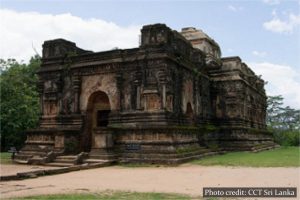
The Thuparama Pilgrimage, also known as the Image House, is a remarkable structure whose builder remains a mystery. Despite being over 900 years old, this building has withstood the test of time and continues to fascinate visitors with its enduring architectural splendor.
The walls of the Thuparama are exceptionally thick, measuring about 7 feet, which speaks to the durability and strength of the structure. Inside, a large seated Buddha statue was originally housed, although nothing remains of the statue today.
Legend has it that the statue was once adorned with precious stones in its eyes. The windows of the building were designed in such a way that sunlight would shine through, casting reflections on the stones and illuminating the Buddha, creating a truly mystical effect. This unique feature would have made the Thuparama a mesmerizing place of worship, where light and stone came together to enhance the spiritual experience.
The Thuparama Pilgrimage stands as a testament to the architectural ingenuity and spiritual devotion of the past, offering a glimpse into the rich history of Polonnaruwa and the reverence given to the Buddha during this period.
Alahana Pirivena
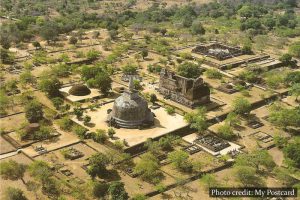
The Alahana Pirivena is a distinguished educational and monastic complex founded by King Parakramabahu I. This site stands as the religious heart of his reign, reflecting his commitment to the restoration and flourishing of Theravada Buddhism in Sri Lanka.
As part of this monastic center, several significant structures can be found, including:
- Kiri Vehera – A stupa that adds to the religious sanctity of the site.
- Lankathilaka Image House – A striking structure that houses Buddhist images and demonstrates the architectural grandeur of the time.
- Baddhasima Prasada – A building with historical importance, adding to the spiritual atmosphere.
- Hospital Complex – A reminder of the advanced knowledge in medicine and public health during King Parakramabahu’s reign.
- Gal Viharaya – A renowned site with magnificent rock-carved statues of the Buddha, showcasing the artistic and cultural achievements of the era.
The Alahana Pirivena is a central landmark of the Polonnaruwa period, where education, spirituality, and royal patronage of Buddhism converged, ensuring the legacy of Theravada Buddhism endured across generations.
Kirivehera Stupa
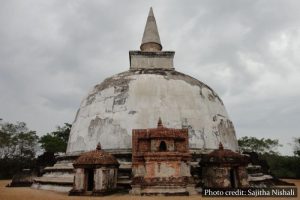
The Kirivehera Stupa was built by King Parakramabahu I and remains one of the most significant monuments within the Alahana Pirivena complex. This stupa stands out due to its distinctive architectural features, which include:
- Triple Berm – A characteristic feature of the stupa's base, adding to its imposing presence.
- Dome – The central structure of the stupa, symbolizing the Buddha's teachings.
- Square Tee – The elevated part above the dome, enhancing the stupa's spiritual symbolism.
- Deity's Enclosure – A sacred area surrounding the stupa, contributing to its religious sanctity.
- Kothkaralla – The umbrella cone, a traditional feature atop stupas, symbolizing the protection of the sacred relics within.
In the late 19th century, H.C.P. Bell, Sri Lanka’s first Archaeological Commissioner, cleared a tunnel that had been dug by treasure hunters. This tunnel led into the stupa’s dome, where he discovered two relic chambers that had been previously ransacked, revealing the site’s historic significance. The Kirivehera continues to stand as a testament to King Parakramabahu’s devotion to Buddhism and his legacy of architectural and spiritual accomplishments.
The Chapter House of Alahana Pirivena
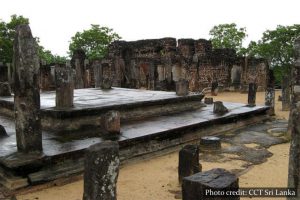
The Chapter House, known as Baddhasima Prasada or Uposathagara, was built by King Parakramabahu I as part of the Alahana Pirivena monastic complex. This monumental structure was initially 12 stories high, making it one of the most impressive buildings of its time.
The purpose of the Chapter House was to serve as a dedicated space for Buddhist monks and their activities. It functioned in a similar manner to the Lovamaha Prasadaya in Anuradhapura, providing a place for monks to congregate for the rehearsal of the Vinaya Pitaka (the code of discipline). The building was designed to accommodate all the monks' needs, offering both the facilities for their religious and communal activities as well as lodging for them during their stay.
The Baddhasima Prasada reflects King Parakramabahu's commitment to the revival of Theravada Buddhism, offering a space where the monastic community could gather in peace and devotion.
Lankathilaka Image House of Alahana Pirivena
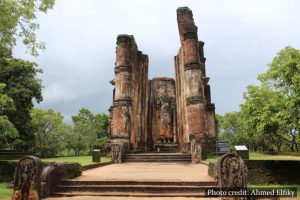
The Lankathilaka Image House of the Alahana Pirivena was established by King Parakramabahu I and remains one of the most striking architectural marvels of the era. This monumental structure was originally believed to be five stories high, showcasing the grandeur of Parakramabahu’s vision for religious and architectural development.
The Lankathilaka Image House is a massive brick building, with two gigantic columns marking its entrance, symbolizing the strength and majesty of the structure. Inside, the highlight is the 40-foot-high standing Buddha statue, which exudes both serenity and awe. The statue, in its immense scale, reflects the importance of Buddhism and the reverence with which it was treated during Parakramabahu's reign.
This image house was part of the Alahana Pirivena, a key religious complex that reinforced the king’s commitment to the resurgence of Theravada Buddhism in the island.
Gal Viharaya of Alahana Pirivena

Gal Viharaya is an exquisite creation by King Parakramabahu I and stands as a testament to the artistic and spiritual achievements of the era. Also known as the Rock Shrine, Gal Viharaya is a collection of remarkable rock sculptures situated to the north of the Alahana Pirivena complex.
This sacred site, also referred to as the ancient Uttararama, features a series of statues of Buddha in all three key positions: seated, standing, and recumbent. Each statue is carved directly into the rock, showcasing the skill of the artisans and the deep spiritual significance placed on these representations of the Buddha.
The statues at Gal Viharaya are not only impressively large but also largely intact, making them some of the most well-preserved and awe-inspiring Buddhist sculptures from ancient Sri Lanka. These captivating figures continue to evoke admiration and serve as a powerful reminder of the island's rich cultural and religious history.
Hospital of Alahana Pirivena
The Hospital of Alahana Pirivena is an intriguing and significant structure that provides insight into ancient Sri Lankan medicine. This oblong building, with a central courtyard surrounded by rooms, was part of the Alahana Pirivena monastic complex and highlights the advanced healthcare practices of the time.
One of the most fascinating discoveries at this site is the medicine trough found in the southern corner room. Shaped like a human body, this trough is a unique artifact that offers a glimpse into the methods of treatment used by ancient healers. Additionally, several medical and surgical instruments have been unearthed at the site. These instruments, showcasing the sophisticated understanding of medical practices, are now displayed at the Central Cultural Fund Museum in Polonnaruwa.
The Hospital of Alahana Pirivena stands as a testament to the holistic approach to health and well-being during the reign of King Parakramabahu I, reflecting the advanced medical knowledge that flourished alongside the religious and educational advancements of the time.
Lotus Pond
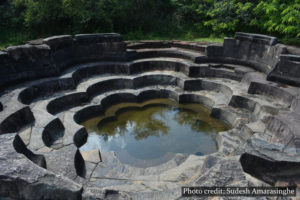
The Lotus Pond is a stunning example of ancient Sri Lankan craftsmanship, renowned for its unique design and exceptional granite work. Shaped like a lotus flower, this stone bath features elegantly tiered levels that mimic the petals of a lotus, providing seating around its edges.
The pond is equipped with underground clay pipelines, ingeniously crafted to fill and empty the pond, showcasing the advanced engineering skills of the time.
This small but remarkable structure stands as a testament to the sophistication of ancient craftsmanship, drawing parallels to other ancient wonders like Puma Punku in Bolivia. The Lotus Pond is not only a symbol of beauty but also an impressive feat of engineering, highlighting the mastery of ancient stonework in Sri Lanka.
Thivanka Pilimage (Image House)
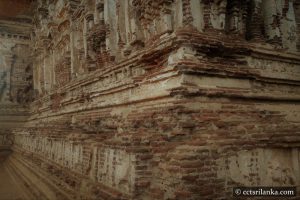
The Thivanka Pilimage was constructed by King Parakramabahu I and is a significant structure within the Jethavanarama Complex. Its name, Thivanka, is derived from the Pali words 'Thi' meaning three and 'Vanka' meaning curved, referring to the three large Buddha statues that are carved in three distinct positions. These statues, standing at an impressive 8 meters tall, are the central feature of this image house.
The building itself measures 133 feet in length and 67.6 feet in width, with walls that are 7-12 feet thick, making the internal space more compact than its exterior suggests.
Inside, the walls are adorned with stunning frescoes depicting the Jataka Stories — tales of the Buddha's previous lives before attaining enlightenment. Many of these vibrant paintings can still be seen in areas where the masonry has remained intact, offering a glimpse into the rich artistic heritage of the period.
Rankot Vehera
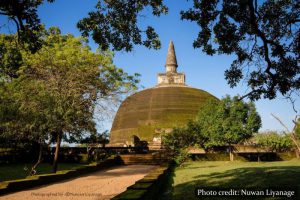
Rankot Vehera is a magnificent stupa built by King Nissankamalla during his reign. Located near the entrance of the Sthupaya, there is a stone seat inscribed with Nissankamalla's writing, which tells the story of the king personally overseeing and witnessing the construction of this grand dagoba.
The structure is surrounded by a stone-paved pathway that leads to the compound, with gateways opening at each of the cardinal points, adding to its architectural grandeur and symbolic alignment with ancient traditions
Shiva Devala 1
Shiva Devala 1 is located at the main entrance of the Polonnaruwa Sacred Quadrangle. This ancient Hindu temple, dedicated to the god Shiva, is an important example of early medieval South Indian temple architecture in Sri Lanka. Built during the reign of the Chola kings, it is one of the oldest and most prominent Hindu structures in Polonnaruwa, reflecting the influence of Hinduism on the region during that era. The temple’s design features typical Dravidian-style architecture, with intricately carved stone pillars and a sanctum where the Shiva lingam would have been placed.
Shiva Devala 2
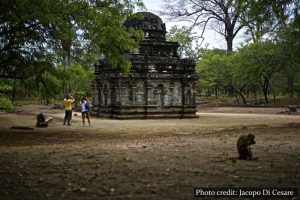
Shiva Devala 2 was built by a Chola king in honor of his queen. This temple, dedicated to the god Shiva, is another significant example of the Chola influence on Polonnaruwa during their rule. The structure follows traditional South Indian temple architecture, featuring a sanctum and intricately carved stone pillars. Notably, Tamil inscriptions can be seen on the south wall of the building, providing historical context and insights into the Chola period's influence in the region. This adds a layer of cultural and historical significance to the temple, connecting it to the broader Tamil heritage in Sri Lanka during that time.
Naipena (Cobra) Vihara in Polonnaruwa
The Naipena Vihara, also known as the Cobra Vihara, is a lesser-known but significant Buddhist site located in Polonnaruwa. The name "Naipena" translates to "Cobra" in Sinhalese, and it is believed that the vihara (monastic complex) was so named because of the architectural features resembling a cobra, possibly the shape of the stonework or the design of its pillars and entrances.
The Vihara is located in a serene area and is often associated with the medieval period of Polonnaruwa. The structure typically includes a small stupa and a Buddha statue, along with remnants of monastic buildings. The design and layout of the Vihara represent the influence of Sinhalese Buddhist architecture during the time of the Polonnaruwa Kingdom, which flourished under the reigns of kings like Parakramabahu I and Nissankamalla.
While the exact history and function of the Naipena Vihara are not as well documented as some other major sites in Polonnaruwa, it still contributes to the broader understanding of Polonnaruwa's Buddhist heritage and its architecture. The remnants of this Vihara add depth to the historical tapestry of the city, which served as the capital of Sri Lanka during the medieval period.
The Statue of King Parakramabahu
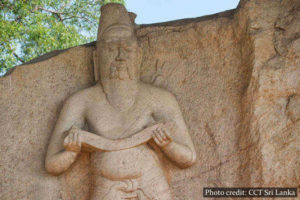
The Statue of King Parakramabahu in Polonnaruwa is an iconic monument believed to be a representation of the great king himself. Standing at a remarkable height of 11.5 feet, this granite statue stands as a testament to the advanced craftsmanship and artistic skills during the Polonnaruwa period (11th-12th centuries).
Controversy Over the Identity
While it is widely believed that the statue represents King Parakramabahu I, some theories suggest that it might instead depict Kapila, an Indian priest from the Pulasthi lineage. This theory ties into the ancient name of Polonnaruwa – Pulasthipura, named after the sage Pulastya. According to these theories, Kapila was a notable figure connected to the Pulasthi family, which is linked to Ravana, the mythical king of Lanka in Hindu mythology, whose grandfather was Pulastya.
This connection adds an intriguing layer to the history of the region, intertwining mythology and history. In Hindu texts, Pulastya was one of the Saptarishi (the Seven Great Sages), and this mythological context elevates the statue's historical significance.
Craftsmanship
The granite craftsmanship of the statue is remarkable, displaying the fine artistry of the Polonnaruwa era. The statue is known for its detailed features and elegant proportions, reflecting the artistic achievements of Sri Lanka's medieval period.
Significance
The statue stands as a monumental symbol of the legacy of King Parakramabahu, who was one of the most significant rulers of the Polonnaruwa kingdom, and is associated with the re-establishment of Buddhism and the great irrigation works. The statue may also symbolize the broader religious and cultural heritage of Sri Lanka during that time.
Whether it is a king or a priest, the statue represents an important piece of Sri Lanka’s artistic and mythological history, and continues to be an important cultural landmark in Polonnaruwa.
Parakrama Samudraya
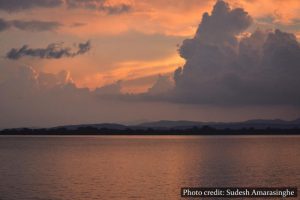
Parakrama Samudraya is one of the most remarkable irrigation reservoirs in Sri Lanka, built during the reign of King Parakramabahu I. It was part of the king's monumental efforts to develop the kingdom’s agricultural infrastructure, and it showcases the advanced engineering and water management systems of the era.
Overview of the Reservoir
- Construction Period: During the reign of King Parakramabahu I (1153–1186).
- Original Setup: Parakrama Samudraya was originally connected with five other tanks: Thopa Vawa | Eramudu Vewa (also called Katu Vewa) | Dumbuthulu Vewa | Kalahagala Vewa & Bhu Vewa
Together, these water bodies formed a vast network for irrigation and water management.
Engineering and Features
- Dam: A temporary dam was initially constructed to prevent water flow between Thopa Vawa and Bhu Vewa. This dam eventually became a permanent road. The dam stretches 14 kilometers in length and stands 40 feet high.
- Area Covered: The Parakrama Samudraya spans over 5,350 acres of land, with an average depth of 25 feet. This vast body of water played a crucial role in the kingdom’s agricultural activities.
- Agricultural Impact: The water from the reservoir irrigates over 18,000 acres of paddy fields, making it one of the most significant irrigation systems of its time and contributing to the prosperity of the region.
Legacy
Parakrama Samudraya is a symbol of King Parakramabahu I's legacy, demonstrating his vision for a sustainable and prosperous agricultural system. The reservoir’s innovative engineering, combined with the king’s strategic management of water resources, allowed for extensive cultivation, contributing to Sri Lanka’s economy for centuries. Today, it remains an important part of Sri Lanka's cultural and historical heritage and continues to serve agricultural purposes.
Poth Gul Viharaya
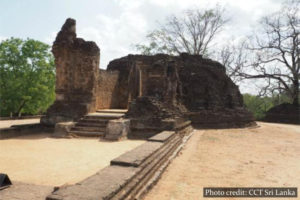
Poth Gul Viharaya is an ancient Buddhist library complex believed to have been constructed during the reign of King Parakramabahu I. It is one of the important educational and religious sites in Polonnaruwa, reflecting the king's commitment to the preservation and study of Buddhist texts.
Features and Structure
- Library Complex: The complex is primarily recognized as a Buddhist library, where monks would have studied and preserved sacred Buddhist writings.
- Ruins: Today, the remains of nine buildings are visible. These structures are believed to have housed monks and scholars dedicated to the study of Buddhist scriptures.
- Wall Paintings: Although the roofs have long since disappeared, some fragments of paintings have survived for almost a millennium. These paintings, still visible on the walls, are a testament to the artistry and cultural importance of the site during its prime.
Historical Significance
Poth Gul Viharaya highlights the intellectual legacy of King Parakramabahu I, who was not only a military and political leader but also a patron of Buddhism and scholarship. The complex would have been an essential place for the study, preservation, and transmission of Buddhist knowledge. Despite the passage of time and the ravages of nature, the surviving remnants, including the paintings and architecture, offer a glimpse into the intellectual and spiritual vibrancy of the era.
The Palace of Nissankamalla
The Palace of Nissankamalla was built during the reign of King Nissankamalla (1187–1196) in Polonnaruwa, a city that was once the heart of Sri Lankan civilization. This palace, like many structures from that era, symbolizes the grandeur and strength of the reign of King Nissankamalla, one of Sri Lanka's most ambitious and renowned kings.
Features and Structure
- Architectural Grandeur: The Palace of Nissankamalla is known for its impressive size and ornate architecture, demonstrating the advanced construction techniques of the time.
- Location: It was located in the Royal Palace Complex of Polonnaruwa, near other important structures like the Vijayanta Pasada (the Royal Palace of Parakramabahu) and the Sacred Quadrangle.
- Function: The palace served as the residence of the king and the administrative center of the kingdom, hosting not only the royal family but also officials, military leaders, and religious figures.
Historical and Cultural Significance
- Nissankamalla's Reign: King Nissankamalla was known for his ambitious projects, which included the construction of temples, reservoirs, and public works. His reign marked a high point in the cultural, political, and economic development of Sri Lanka, and the palace served as a symbol of his power and influence.
- Inscriptions: There are inscriptions found around the palace complex, some of which commemorate King Nissankamalla's achievements and the development projects he undertook throughout the kingdom.
- Palace Layout: Though much of the palace has been lost over time, some remnants show evidence of a multi-story structure, with grand halls, corridors, and rooms that reflect the luxurious lifestyle of the king and the royal family.
Decline and Preservation
- Over the centuries, the Palace of Nissankamalla deteriorated due to natural disasters, wars, and looting. However, parts of the structure, particularly the foundations and inscriptions, still survive today as an important historical and archaeological site.
- The palace, along with other significant sites in Polonnaruwa, is protected as part of the Polonnaruwa Ancient City, which is a UNESCO World Heritage Site.
Today, the Palace of Nissankamalla serves as a testament to the king's ambition, architectural achievement, and the rich history of Polonnaruwa during one of Sri Lanka's most prosperous periods.
Polonnaruwa Museum
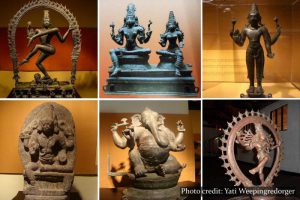
The Polonnaruwa Museum is a key cultural institution located in the ancient city of Polonnaruwa, Sri Lanka. It serves as a repository for artifacts, sculptures, and historical items that highlight the rich history and culture of Polonnaruwa and the Polonnaruwa Kingdom during its peak. The museum offers visitors a chance to explore the archaeological, historical, and cultural significance of one of Sri Lanka's most important ancient cities.
Location and Structure
- The museum is located near the historical ruins of Polonnaruwa, close to significant sites such as the Royal Palace Complex, Gal Viharaya, and the Sacred Quadrangle. It is strategically placed for easy access by those touring the ancient city.
- The building itself is modern and well-maintained, offering a comfortable and educational space for visitors to view exhibits that date back over a thousand years.
Collections and Exhibits
- Sculptures and Statues: The museum displays a variety of stone carvings, Buddha statues, and other sculptural art from the Polonnaruwa period. The stone craftsmanship in this period is highly refined, and many of these artifacts were originally part of temples and religious complexes such as Gal Viharaya and Vatadage.
- Inscriptions: Several stone inscriptions detailing the reigns of kings like Parakramabahu I and Nissankamalla are housed in the museum. These inscriptions provide valuable information on the politics, religion, and social organization of the Polonnaruwa Kingdom.
- Artifacts: The museum also displays everyday items, including pottery, tools, jewelry, and coins, which help provide a deeper understanding of daily life during the reign of the Polonnaruwa Kings.
- Religious Artifacts: A significant portion of the museum is dedicated to the Buddhist artifacts, reflecting the central role of Theravada Buddhism during the period. Items like stone tablets, relics, and stupas help illustrate the religious devotion and architectural achievements of the era.
- Models and Reconstructions: The museum features models and reconstructed images of key sites in Polonnaruwa, such as the Royal Palace, Vatadage, and Rankot Vehera, providing visitors with a visual representation of what these sites may have looked like during their prime.
Educational Role
- The Polonnaruwa Museum plays a critical role in preserving and showcasing the history of the region. It educates visitors on the legacy of the Polonnaruwa Kingdom and its significant contributions to Sri Lanka's history.
- It is an excellent resource for historians, archaeologists, and tourists interested in learning about the archaeological wonders of Polonnaruwa and how it became a central hub for politics, religion, and culture during the 11th and 12th centuries.
Visitor Experience
- The museum is designed to provide an immersive experience with informative displays, clear signage, and sometimes interactive exhibits. It also offers guided tours, giving deeper insights into the history of Polonnaruwa and its rulers.
- The museum is typically part of a larger cultural experience, where visitors can explore the ancient ruins of the city before coming to the museum for a deeper understanding of the artifacts they see.
Convenient Pick-Up and Drop-Off Options
At CCT Sri Lanka, we prioritise your comfort and convenience with our flexible pick-up and drop-off services. Our team of service-oriented drivers is registered with the Sri Lanka Tourist Board, ensuring you receive the highest standard of professionalism and care.
Our Services Include:
- Airport Pick-Up: Arrive with ease as we provide reliable transportation from Bandaranaike International Airport (BIA) or Palali International Airport (JAF). Start your journey smoothly and stress-free.
- Hotel Pick-Up: Already arrived? We’ll pick you up directly from your hotel or any other location, tailored to your schedule.
- Customizable Drop-Off: Whether you’re returning to the airport or heading to another destination, we’ll arrange a drop-off location that suits your needs.
Let us take care of the logistics while you focus on enjoying your adventure in Sri Lanka. To reserve your vehicle, select your date from the drop-down menu for your destination or contact us directly for personalised assistance. Experience the difference of exceptional service with CCT Sri Lanka.



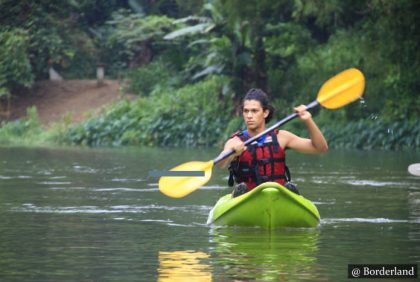
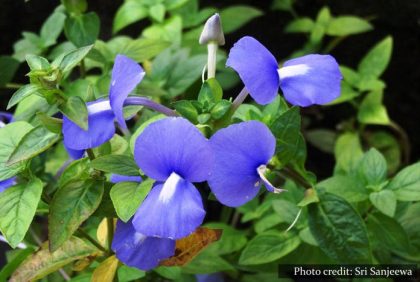
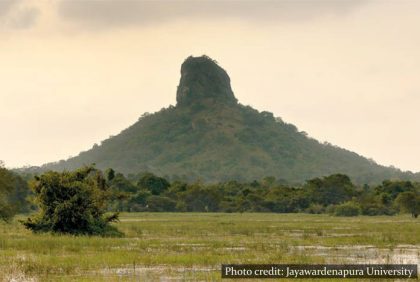
Reviews
There are no reviews yet.